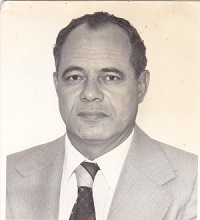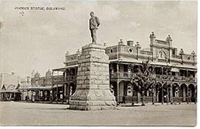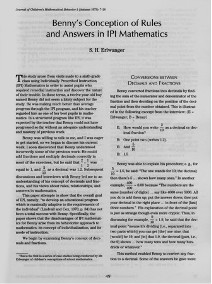 The website is in construction. New files will be uploaded as soon as they are available.
The website is in construction. New files will be uploaded as soon as they are available.
STANLEY HERBERT ERLWANGER
Bulawayo 1934 - Harare 2003

Brief scientific biography

Bulawayo before the second world war
Stanley Erlwanger was born in 1934 in Bulawayo, the second largest town in what was then called Southern Rhodesia, a British colony, since its independence known as Zimbabwe. In Africa, he had a rich career as a high school math teacher, a Senior Inspector of Schools in Zimbabwe, and as Head of the Department of Science Education and Dean of the Faculty of Education at the University of Botswana and Swaziland. In the seventies, he moved to the United States. He got his Ph.D. with Robert Davis at the University of Chicago in 1974. In the period 1974-1976 he was a member of the Princeton Institute of Advanced Study, and in those years he was also engaged as a director of major projects on the mathematical development of children at Florida State University. From 1980 to 1991, he taught mathematics at Concordia University in Montreal, Canada.
Stanley Erlwanger was not only an officer of the ICMI in the period 1979-1982, but he was also a member of the National Council on Teacher Education of Botswana and of the Regional Math Panel of Botswana, Lesotho and Swaziland. He was a contributing editor of the Journal of Children's Mathematical Behaviour from 1975 until 1997.
Stanley Erlwanger died in Harare, the capital of Zimbabwe, in June 2003.
Pioneering Case Studies
In 1973, Erlwanger published an article under the title of 'Benny's conceptions of rules and answers in IPI mathematics'. IPI stand for Individual Programmed Instruction. It became a famous article, still known and cited today, and included in the NCTM publication Classics in Mathematics Education Research. In 2005, John Mason wrote about Erlwanger's article:
"For example, Stanley Erlwanger made relevations that are as fresh now as they were startling then (...). His article shocked the developers of programmed learning, and it will shock those who try to engineer teacher-independent materials."

In Erlwanger's doctoral dissertation and other publications several more case studies were described. In later years, he published with Victor Byers, a colleague from Concordia University where he was then working, some more general articles on mathematics education, and around 1990 with Joseph Brody, another colleague from Concordia, four articles on the use of technology in mathematics education. When he was at Concordia, he also was actively involved with math teachers and he played a role in initiating curricular reforms.
But no doubt, Stanley Erlwanger will be remembered most for the first article that he published and that made him famous: Benny's conceptions.
Literature
About Stanley H. Erlwanger
2003, In Memoriam of Stanley H. Erlwanger, Concordia Thursday Report, 28, 1, sept. 11
B. SPEISER, C. WALTER 2004, Remembering Stanley Erlwanger, For the Learning of Mathematics, 24, 3
Publications by Stanley H. Erlwanger
S.H. ERLWANGER 1973, Benny's conception of rules and answers in IPI mathematics, Journal of Children's Mathematical Behaviour, 1, 2, 7-26, Reprinted in 2004, Classics in Mathematics Education Research, Reston, VA, NCTM
S.H. ERLWANGER 1975, Case studies of children's conceptions of mathematics, Journal of Children's Mathematical Behaviour, 1, 3, 157-283
S.H. ERLWANGER 1975, Case studies of children's conceptions of mathematics, Doctoral dissertation, Ann Arbour, Michigan
S.H. ERLWANGER 1975, The Observation Interview Method and Some Case Studies, Proceedings of the Conference on the Future of Math Education, Florida State University
S.H. ERLWANGER, M. BEHR, E. NICHOLLS 1975, How Children View Equality Sentences, PMDC Technical Report nr. 3, Florida State University
S.H. ERLWANGER 1978, The African University in Development, Botswana Journal of African Studies, 1, 1 189-192
S.H. ERLWANGER, M. BEHR, E. NICHOLLS 1980, How children view the equal sign, Mathematics Teaching, 92, 13-15, 1980
S.H. ERLWANGER, M. BERLANGER 1983, Interpretations of the Equal Sign among Elementary School Children, Proceedings of the North American Chapter of th International Group for the Psychology of Mathematics Education, Montreal
S.H. ERLWANGER, V. BYERS 1984, Content and Form in Mathematics, Educational Studies in Mathematics, 15, 3, 259-275
S.H. ERLWANGER, V. BYERS 1985, Memory in Mathematical Understanding, Educational Studies in Mathematics, 16, 3, 259-281, 1985
S.H. ERLWANGER, J. BRODY 1987, A calculator-based computational approach Part.1 Linear functions and equations', International Journal of Mathematical Education in Science and Technology, 18, 3
S.H. ERLWANGER, J. BRODY 1988, A calculator-based computational approach, Part. 2 Quadratic functions and equations, International Journal of Mathematical Education in Science and Technology, 19, 5
S.H. ERLWANGER, J. BRODY 1990, A calculator-based computational approach, Part. 3 The Differentiation, International Journal of Mathematical Education in Science and Technology, 21, 4
S.H. ERLWANGER, J. BRODY, S. ROSENFIELD 1991, A calculator-based computational approach, Part. 4 On Differences and Graphs, International Journal of Mathematical Education in Science and Technology, 22, 5
Author
Harm Jan Smid
Delft University of Technology
harm.smid@t-online.de
